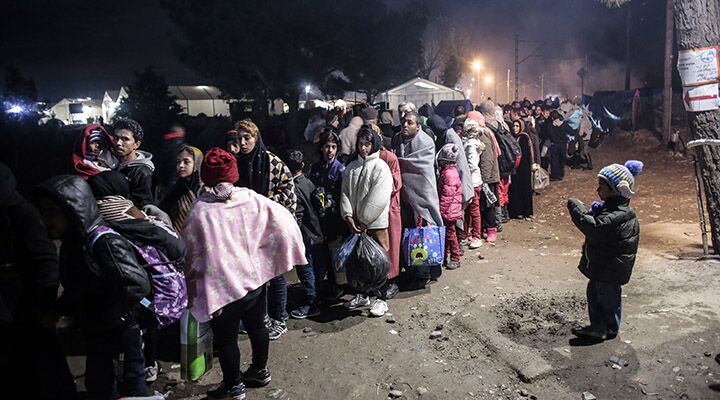
How Many Syrian Refugees Are Terrorists?
When the wave of refugees from Syria reached its peak in September, European politicians opened wide their borders. Ever so compassionate, they welcomed the refugees by the thousands and reassured their citizens that their acts of kindness would not jeopardize national security.
However, by so doing, they completely disregarded reality—not to mention the warnings from both terrorists and counterterrorism experts. Leaders like German Chancellor Angela Merkel even went as far as threatening to take legal action against those nations that were wary of accepting Syrian refugees, citing Geneva Convention protocols on refugees.
Remarkably, the United States is following in Europe’s footsteps!
Politicians are opening U.S. borders to Syrian refugees. In their compassion, they have already received about 2,000. In his Thanksgiving Day radio message, President Barack Obama compared Syrian refugees to the first Pilgrims who sailed to America on the Mayflower in September 1620.
Like European politicians, the Obama administration has reassured Americans that accepting refugees would not jeopardize national security—completely disregarding reality. It has ignored its track record of miscalculating serious terrorist threats. You might recall the dangerously flawed comparison of the Islamic State to a JV team and recent false assurances that the Islamic State was a contained threat.
In its reassurances, the Obama administration also disregarded the warnings from both terrorists and counterterrorism experts. On nbc’s Meet the Press program on November 15, White House deputy national security adviser Ben Rhodes said:
We have very extensive screening procedures for all Syrian refugees who have come to the United States. There is a very careful vetting process that includes our intelligence community, our National Counterterrorism Center, the Department of Homeland Security, so we can make sure that we are carefully screening anybody that comes to the United States.
However, the counterterrorism experts themselves say it’s impossible to thoroughly vet the Syrians seeking refuge in American cities. About that vetting process, fbi director James Comey said in October:
We can only query against that which we have collected. And so if someone has never made a ripple in the pond in Syria in a way that would get their identity or their interest reflected in our database, we can query our database till the cows come home, but [nothing will] show up because we have no record on that person.
You might also recall that the U.S. completely failed to thoroughly vet rebels it allied with in Syria.
When European authorities revealed that at least one of the suspects in the Paris attacks entered Europe on the Syrian refugee pretense, 31 American states declared they would not accept any Syrian refugees under current circumstances. And not unlike German Chancellor Merkel, the Obama administration threatened legal action against those states, citing the Refugee Act of 1980.
A Lesson From Paris?
The Paris attacks sent a strong warning to Europeans about the danger posed by the influx of migrants.
Prior to the attacks, in September, the Islamic State had claimed that 4,000 of its terrorists had already traveled to Europe disguised as Syrian refugees. Syria’s ambassador to India, Riad Abbas, reaffirmed those claims shortly after the Paris attacks when he said, “Among the refugees who went to Europe, maybe more than 20 percent belong to [Islamic State] groups. Now Europe has received bad element[s] into their ground. They will face further problem[s] in future.”
Likewise, the United States will face problems in the future if it brings in Syrian refugees that it is not capable of vetting, as the fbi affirmed.
On November 19, the fbi said its intelligence officials are maintaining “tight surveillance” on “dozens” of suspected radicals plotting attacks similar to those in Paris. A week later, Fox News reported that the fbi’s elite surveillance teams are tracking at least 48 high-risk Islamic State suspects in the United States.
(Listen to our discussion on this subject here.)
We don’t know for sure how many of those suspects are Syrian refugees. But we do know that it’s impossible to thoroughly vet them. Some people might argue that those “dozens” of Islamic State suspects are born-and-bred American citizens who converted to Islam and turned rogue. But doesn’t that reveal the extent of the influence the Islamic State has even in the United States? How much more influence could it have on migrants and refugees from Syria?
At least 66 people have been arrested in the U.S. in the past 18 months for Islamic State-related terrorist plots. And yes, some of those would-be terrorists were refugees.
A Spring 2015 Global Attitudes survey by the Pew Research Center indicated that among 11 representative nation-states in the Muslim world, as many as 14 percent of a population had a favorable opinion of the Islamic State; as many as 62 percent of a national population didn’t know whether their opinion of the terrorists was favorable or not.
These numbers are “indicative of at least 63 million isis supporters—and potentially upwards of 287 million if the undecided are included in the calculation,” wrote Sierra Rayne for the American Thinker. “These numbers suggest there are, at a minimum, hundreds of millions of isis supporters worldwide.”
And to make matters worse, scholars on Islam tell us that Muslim migration is an integral part of strategy for “remaining and expanding”—for conquest.
A week prior to the Paris attacks, astute observers, like former German Defense Minister Karl-Theodor zu Guttenberg, said it was “only a matter of time” before Germany experienced a terrorist strike. Although Germany itself wasn’t hit (yet), its next-door neighbor was.
Can the same observation be made for the United States?
Just look at Europe’s history since September. Then study what Bible prophecy says about terrorism and “the stranger that is within.”
